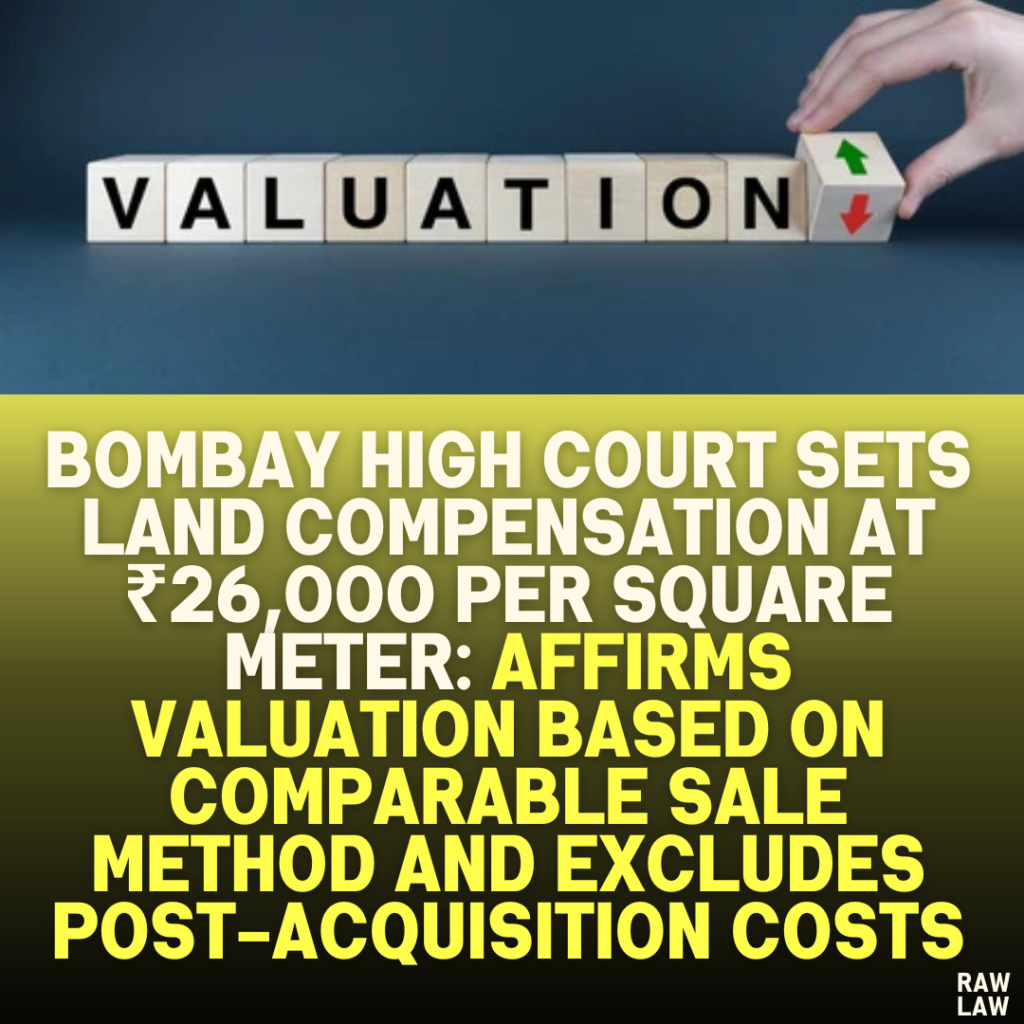Court’s Decision
The Bombay High Court held that the market value of land acquired under the Land Acquisition Act, 1894, must be determined based on its condition and market potential as of the date of the acquisition notification. Costs incurred by the acquiring body after acquisition, such as levelling or construction expenses, are irrelevant to this determination. The court fixed the market value of the land at ₹26,000 per square meter.
Facts
- The case involved the acquisition of 1792.82 square meters of land in Goregaon (East), Mumbai, designated for constructing an administrative building for the Mahanagar Telephone Nigam Limited (MTNL).
- A notification under Section 126(4) of the Maharashtra Regional and Town Planning Act, 1966, was issued on 04.08.1994, with the relevant date for valuation being 27.10.1994.
- The Special Land Acquisition Officer (SLAO) awarded compensation at ₹2,800 per square meter in 1996. The claimants challenged this valuation, seeking enhancement to ₹20,000 per square meter.
- Post-acquisition, the MTNL incurred expenses for levelling the land and constructing the building, which the acquiring body argued should be deducted from the compensation amount.
Issues
- Whether costs incurred by the acquiring body after acquisition can be considered in determining the market value.
- What constitutes the fair market value of the acquired land as of the relevant date.
Petitioner’s Arguments
- The claimants contended that the SLAO undervalued the land by ignoring its location advantages, development potential, and industrial zoning.
- They argued that the land was situated in a prime area with significant development potential, including proximity to Goregaon Railway Station, Western Express Highway, and industrial zones.
- The petitioners presented evidence of three comparable sales in the vicinity to establish a higher market value of ₹26,000 per square meter.
Respondent’s Arguments
- The acquiring body argued that expenses incurred after the acquisition, including ₹8,39,000 for levelling and construction, should be deducted from the market value.
- It contended that the SLAO’s award was reasonable and aligned with government rates for 1994.
Analysis of the Law
- Statutory Provisions:
- Section 23 of the Land Acquisition Act, 1894, requires the market value to be determined as of the date of the acquisition notification.
- Section 18 allows landowners to challenge SLAO’s award for inadequate compensation.
- Comparable Sale Method, as upheld in Chimanlal Hargovinddas v. Special Land Acquisition Officer, mandates reliance on recent, similar transactions to determine market value.
- Rejection of Post-Acquisition Costs:
- The court held that costs incurred by the acquiring body post-acquisition are irrelevant under the Land Acquisition Act.
- Such costs, being unrelated to the land’s intrinsic value as of the acquisition date, cannot form the basis for deductions.
- Comparable Sales:
- The court relied on certified sale deeds of properties near the acquired land, noting their proximity in time and location to the relevant date.
- The valuation method considered features such as accessibility, development, and neighborhood amenities.
Precedent Analysis
- Chimanlal Hargovinddas v. Special Land Acquisition Officer:
- This case established that the market value must be determined using comparable sale transactions.
- The value must reflect what a prudent buyer would pay for the land in an open market at the relevant date.
- Government of Bombay v. Merwan Moondigar Aga:
- This case clarified the definition of “market value” as the price a willing buyer would pay to a willing seller under ordinary conditions.
- Majas Madhu Co-operative Housing Society Case:
- The court reiterated the importance of using certified sale transactions as benchmarks for valuation.
Court’s Reasoning
- The court examined the evidence presented by the petitioners, including the expert valuer’s report and certified sale deeds.
- It noted that the SLAO’s valuation was arbitrary, having deducted 50% of the assessed market value without justification.
- The post-acquisition costs incurred by the acquiring body were deemed irrelevant since they occurred a decade after the acquisition.
- The court determined that the claimants had sufficiently demonstrated the land’s value based on its location, development potential, and comparable sales.
Conclusion
The court awarded compensation at ₹26,000 per square meter for the acquired land. It excluded the costs incurred post-acquisition and directed the acquiring body to adhere to the principles of the Comparable Sale Method.
Implications
This judgment reinforces the principle that compensation for acquired land must reflect its market value at the time of acquisition, independent of subsequent developments. It emphasizes the importance of using reliable and comparable sales data to ensure fair valuation for landowners.
